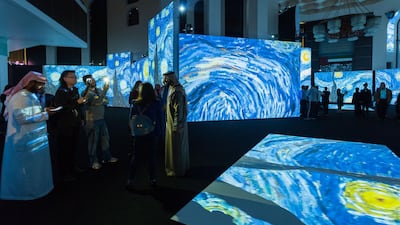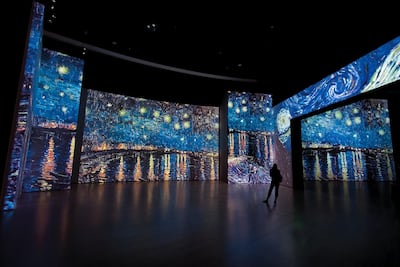There are a couple favourite shibboleths about art and artists. In few of them do artists make out well. Many feel, for example, that artists do best when poor. Recessions, in this world view, are deemed the best way to spur artistic activity. Others feel that artists do best when mad. And obviously, poor and mad is the very best combination.
Enter Vincent Van Gogh.
The late 19th-century Dutch artist enjoys a fame that exceeds that of most artists. Born in the southern Netherlands, Van Gogh moved to Paris at the moment when Impressionism and Post-Impressionism were shifting the scope and ambitions of painting. He struggled with depression, which continued after he left Paris for the south of France.
There he had 10 psychotic episodes in two years and admitted himself to a mental asylum, which has since capitalised on Van Gogh's fame and rebranded itself the Clinique Van Gogh. During this time and immediately following, he produced some of the most famous paintings of the period: Cafe Terrace at Night (1888), The Starry Night (1889), Irises (1889), Portrait of Dr. Gachet (1890) and, of course, Self-Portrait with Bandaged Ear (1889), which commemorates the now infamous incident when, in distress, he sliced off a portion of his ear, wrapped it, and sent to a woman he knew. He committed suicide in 1890, at the age of 37.
Van Gogh is the subject of an unusual new exhibition in Abu Dhabi and Dubai, which eschews – as the website put it – "traditions of tiptoeing through unnervingly silent galleries" for a more engaging, even theatrical presentation of his life and work. Arrayed across the ground floor of the National Theatre in Abu Dhabi, and moving to the Dubai Design District in March, Van Gogh Alive – The Experience delivers, instead, an encounter in which Van Gogh paintings move across giant screens, accompanied by a full-power soundtrack and historical images of Van Gogh's time: pictures of Paris streets, the Dutch countryside, nurses in the asylum or his contemporaries.
Classical music, some of it of the period, accompanies the digital slide show. There is much to learn about Van Gogh's life here, and the exhibition opens avenues towards imagining oneself in his past. But there are problems with such an active presentation as well. Screens display quotes by Van Gogh that attest how insanity is part and parcel of artistic genius: "only when I fall, do I get up again," or "I cannot, suffering as I am, do without something which is greater than I, which is my life, the power to create". The latter is from a letter to his brother Theo in 1888, about a year before he admitted himself to the asylum.
Leaving aside the question of whether insanity is artistically helpful – rather than a tortuous condition for those who experience it – these quotes help to create the exhibition’s impression that the most interesting part of Van Gogh’s work is his madness. It’s not just images of irises and the star-filled nights that scroll past on these screens, it’s Van Gogh the mad genius, Van Gogh the struggling artist (scholars point to his economic circumstances as one of the reasons he so often painted flowers, a cheap and plentiful subject), Van Gogh the tragic hero. This limits our understanding of Van Gogh and what he spent his life struggling to make – his paintings.
A diorama at one end of the exhibition recreates the blue-walled bedroom from his painting of 1888. What is significant about his bedroom, however; is not the bed, or the walls, or the thin towel hanging by the mirror, but Van Gogh's rendition of them: his bright colour and skewed and slightly flattened perspective, which evoke a Japanese print as much as a representational depiction.
Though the wall text helps elucidate these readings, the fact that the painting itself is not there means the viewer cannot reflect on this nor on the way the finer texture of his brushwork adds to the painting’s whole.
There are many different ways to display art besides pristine white galleries where nothing should be touched or heard – you can look, for example, at the Louvre's exhibition display of its current From One Louvre to Another for an attempt at evoking a more historically accurate display. But in an installation such as this, when the viewer is dazzled by images and sound, you could be forgiven for simply experiencing Van Gogh rather than considering his work for yourself.
Van Gogh Alive – The Experience is at the National Theatre in Abu Dhabi until February 26, and then travels to Dubai Design District from March 11 to April 23
_______________
Read more:
See Vincent van Gogh's Sunflower paintings together for the first time, courtesy of Facebook
The five gifts Louvre Abu Dhabi offers to the UAE and the world
Art in the UAE: the exhibitions and installations to look out for in 2018
_______________





